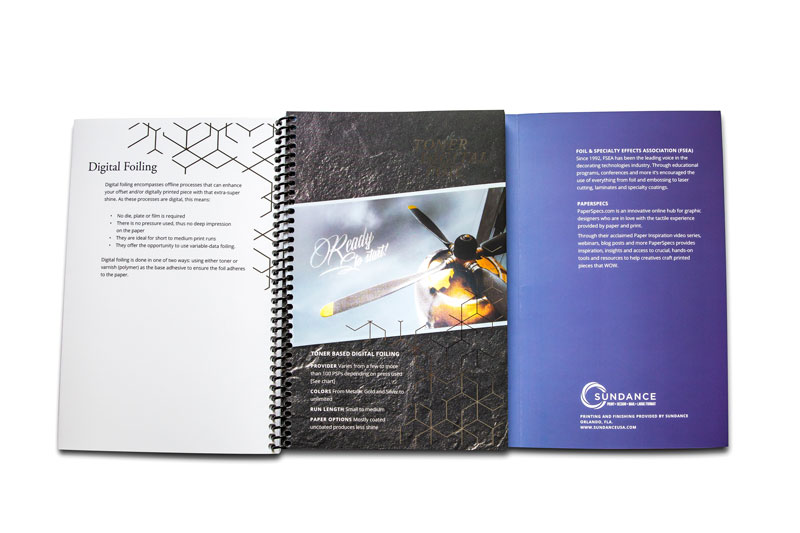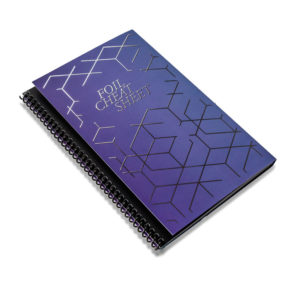
by Melissa Larson, contributing writer
PostPress
 It’s hard to make use of a finishing option if you don’t know it’s available. A significant new graphics resource for the printing and decorating industries has professionals and creatives asking each other, “Do you have the Foil Cheat Sheet?”
It’s hard to make use of a finishing option if you don’t know it’s available. A significant new graphics resource for the printing and decorating industries has professionals and creatives asking each other, “Do you have the Foil Cheat Sheet?”
The Foil Cheat Sheet originated as a joint project between the Foil & Specialty Effects Association (FSEA), and online graphics hub PaperSpecs.
“This project was inspired by the countless times I’ve mentioned digital foiling in presentations or conversations at design conferences, such as HOW Design Live and Adobe MAX, only to discover that no one had any idea what I was talking about,” said Sabine Lenz, principal at design firm PaperSpecs, who spearheaded the project, along with FSEA.
“To me it was vital that creatives have an overview of their foiling options – especially the short-run ones provided by digital; something that they could turn to as a reference time and time again,” she added.
Limited edition
To provide designers and others with real-world examples of these techniques, PaperSpecs, in collaboration with FSEA and Orlando-based printer and finisher SunDance (FSEA member), produced a limited-edition print version of the Foil Cheat Sheet for distribution to select audiences. This 6″x9″ coil-bound collector’s item features a wraparound cover, and interior pages that actually use some of the same digital foiling options discussed inside, as well as soft-touch lamination and French folds.
PostPress asked Lenz what makes this guide better than anything else currently out there. “There are ample references for hot foiling, of course, and some cold foil ones,” she said. “But when it comes to digital foiling with the ever-increasing options available, there really was a need to see all the benefits and limitations of each system laid out side-by-side. To the best of my knowledge, this has never existed before. It’s certainly never been done this clearly.”
Jeff Peterson, FSEA’s executive director, agreed. “When Sabine Lenz and PaperSpecs approached us about partnering on the project, it was really a no-brainer. We have continued to get a lot of questions about all the newer, digital foil technologies and where they fit in with more traditional foil stamping and even cold foiling.”
FSEA worked closely with PaperSpecs to put together the text for the Foil Cheat Sheet and outline the advantages and disadvantages of each type of metallic foil process.
What’s inside
The Cheat Sheet contains a section detailing and illustrating each of the following techniques and materials:
Hot Foil Stamping
Cold Foil Transfer
Digital Foiling
Toner Digital Foil
Varnish Digital Foil
Foil Substrates
For each, the guide lists available providers, colors available, run lengths, maximum sheet sizes, paper options (coated or uncoated), advantages and disadvantages.
For instance, for Varnish Digital Foil, the guide offers the following information:
Provider: Varies from 40+ to more than 100 print service providers (PSPs) depending on press used.
Colors: From metallic gold and silver to unlimited.
Run Length: Small to medium.
Advantages: No dies, plates or film required, so a good option for shorter runs; and the ability to use foil for personalization. Adding clear polymer on top of the foil gives that extra tactile (embossed-like) feel.
Disadvantages: Not as feasible for larger-size foil areas, and limitations on paper stocks and foil colors. Polymer-based foiling is not commonly overprinted—the foil color you choose is the color you get.
At the back of the piece is a foldout chart comparing all techniques side by side. We asked Lenz for an example of how a graphic designer or PSP might use the piece to plan a project.
“For those times when printers just need to cut to the chase and compare all the various types of foiling at once, we included a handy fold-out chart at the back,” she explained. “With one glance printers can see which techniques are overprintable, what colors are possible, and the maximum sheet size the different foil options will accommodate, among other vital pieces of information.
“With budget always being a concern, a vital piece here is the recommended print runs. Many print customers are not aware that, thanks to digital foiling options, they can run as few as one or 10 or 100 pieces. On the other end of the spectrum there is cold foil transfer, which makes economic sense for much larger print runs – but again, many customers are not aware of their options,” she said.
How did they print that?
Kandi Johansmeyer of SunDance walked PostPress through the process of printing and finishing the Cheat Sheet, with all the decorating techniques used.
- The 4-color was printed on an HP Indigo 7 series.
- All pages were then laminated with a soft-touch lamination.
- Some of the pages were then run on a Heidelberg Versafire CV, a digital press with special-effect colors.
- These were then run through the laminator, where toner reactive foil was applied.
- Other pages in the guide were run on SunDance’s MGI JETvarnish 3D digital print enhancement system. They were then run though a laminator with digital UV reactive foil.
FSEA will be gearing up for a second, larger print and foil run of the Foil Cheat Sheet. The goal is to make it available to FSEA members and others in the industry and provide a real tool to help everyone from designers and end users to printers and finishers.
“We worked extremely hard with FSEA members, PaperSpecs and others involved in the metallic foil industry to create the Foil Cheat Sheet and make it as user friendly as possible,” explained Peterson. FSEA will provide an opportunity for its members and others to order quantities of the Foil Cheat Sheet as soon as January 2019. Peterson said that FSEA will continue to update members and others on the progress of a new run of the Foil Cheat Sheet.
“While the book’s high production values and foiling prevent us from offering a copy to absolutely everybody who wants one, we’ve made all the information contained within its pages available to all in the form of a free PDF available for download,” said Lenz. PaperSpecs reaches over 18,000 designers and print service providers through its website, emails and webinars.
When asked about industry reaction to the piece thus far, Lenz commented: “We have only shared the piece with select audiences at PRINT 18 and a number of design influencers, and the response has been amazing. We are receiving requests for larger quantities, so they can be shared within agencies and PSPs. Many, even in the print industry, were not aware of the possibilities. Our goal at PaperSpecs has always been to explain things as simply as possible while providing the crucial information needed.”
A free download is available at www.foilcheatsheet.com. More information on ordering a print/foil version of the Foil Cheat Sheet will be available soon on the FSEA website at www.fsea.com.


